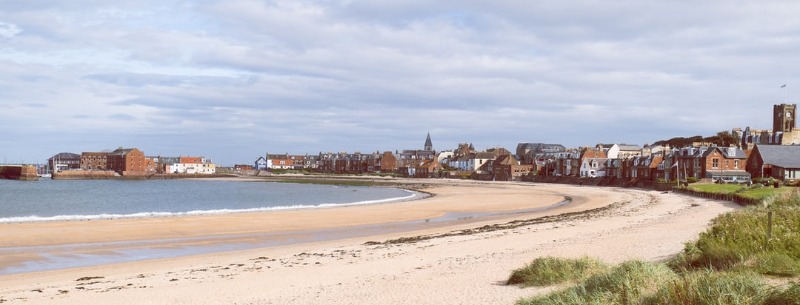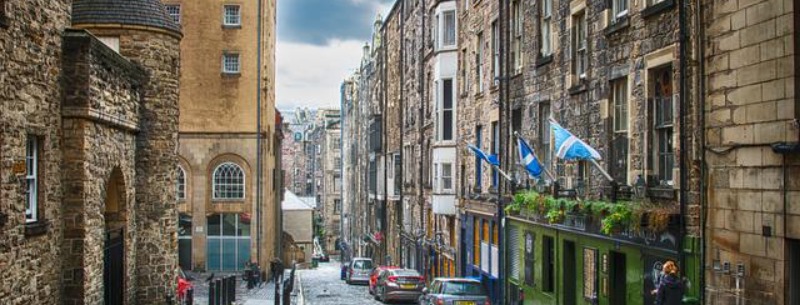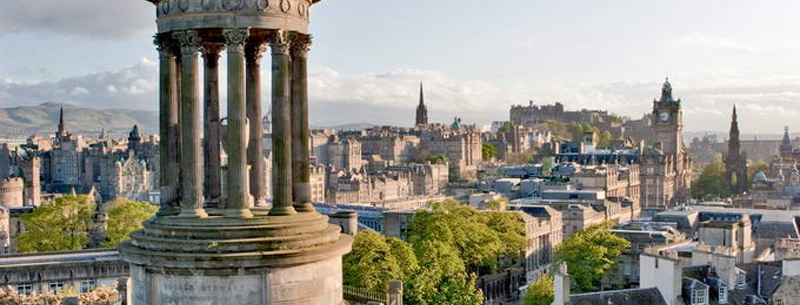2025 Scotland Vacation Guide
The Scottish capital, Edinburgh, is a handsome and ancient city, famous for its magnificent castle and Palace of Holyroodhouse as well as for a world-acclaimed international arts festival and some excellent museums – not least the outstanding National Museum of Scotland.
A short journey west is Glasgow, a sprawling industrial metropolis that has done much to improve its image in recent years and can now boast a range of fine museums and galleries to complement the impressive architectural legacy of its eighteenth- and nineteenth-century heyday
Southern Scotland, often underrated, features some gorgeous scenery, but nothing quite to compare to the shadowy glens and well-walked hills of the Trossachs, or to the Highlands, whose multitude of mountains, sea cliffs, glens, and lochs cover the northern two-thirds of the country. Inverness is an obvious base, although Fort William, at the opposite end of the Great Glen near Ben Nevis, Britain’s highest mountain, is an alternative.
Some of Britain’s most thrilling wilderness experiences are to be had on the Scottish islands, the most accessible of which extend in a long rocky chain off the Atlantic coast, from Arran through Skye (the most visited of the Hebrides) to the Western Isles, where the remarkably hostile terrain harbors some of the last bastions of the Gaelic language. At Britain’s northern extreme lie the sea- and wind-buffeted Orkney and the Shetland Islands, whose rich Norse heritage makes them distinct in dialect and culture from mainland Scotland, while their wild scenery offers some of Britain’s finest birdwatching and some stunning archeological remains.
Food in Scotland
Though the British still tend to regard eating as a functional necessity rather than a focal point of the day, great advances towards a more sophisticated appreciation of the culinary arts have been made in recent years. Every major town has its top-range restaurants, many of them boasting awards for excellence, while it’s nearly always possible to eat well and inexpensively, thanks chiefly to the influence of Britain’s various immigrant communities. However, the pub will long remain the center of social life in Britain, a drink in a traditional “local” often making the best introduction to the life of a town.
In many hotels and B&Bs you’ll be offered what’s termed an ” English breakfast ” – or Welsh or Scottish in the respective countries – which is basically sausage, bacon and eggs plus tea and toast. This used to be the typical working-class start to the day, but these days the British have adopted the healthier cereal alternative, and most places will give you this option as well. Traditionally, a ” Scottish breakfast ” would include porridge – properly made with genuine oatmeal and traditionally eaten with salt rather than sugar, though the latter is always on offer. You may also be served kippers or Arbroath smokies (delicately smoked haddock with butter), or a large piece of haddock with a poached egg on top. Oatcakes (plain savory biscuits) and a “buttery” – not unlike a French croissant – will often feature.
For most overseas visitors the quintessential British meal is fish and chips (known in Scotland as a “fish supper”, even at lunchtime), a dish that can vary from the succulently fresh to the indigestibly oily – it’s little wonder that lashings of salt, vinegar, and tomato ketchup or the fruitier brown sauce are common additions. The classier places have tables, but more often they serve takeaway (takeout) food only, sometimes supplying a disposable fork so that you can guzzle your roadside meal with a modicum of decorum. Fish-and-chip shops (” chippies “) can be found on most high streets and main suburban thoroughfares throughout Britain, although in larger towns they’re beginning to be outnumbered by pizza, kebab, and burger outlets.
Other sources of straightforward food throughout the day are ” greasy spoons ” (which tend to close at around 6-7pm), and pubs (which usually stop serving food by 9pm), where you’ll often find plain “meat-and-two-veg” dishes: steak-and-kidney pie, shepherd’s pie (minced lamb or beef covered in mashed potato, and baked), chops and steaks, accompanied by boiled potatoes, carrots or some such vegetable. However, a lot of British pubs now take their food very seriously, having separate dining areas and menus that can compete with some of the better mid-range restaurants.
In the smallest villages, the pub may be the only place you can eat. Another recent development is the growing number of specialist vegetarian restaurants , especially in the larger towns, and the increasing awareness of vegetarian preferences in other eating places. In Wales especially you’ll come across dozens of small, inexpensive wholefood cafés, often doubling up as alternative resource centers. Also on the rise in the major towns are vaguely French brasseries , informal bar/restaurants offering simple meals from around £10-12 per head and often with a set lunchtime menu for around half that.
Britain has its diverse immigrant communities to thank for the range of foods in the mid-range category. Of the innumerable types of ethnic restaurants offering good-value high-quality meals, you’ll find Chinese, Indian, and Bangladeshi specialties in every town of any size, with the widest choice in London and the industrial cities of the Midlands and the North. Other Asian restaurants, particularly Thai and Indonesian, are now becoming more widespread in England, but are generally a shade more expensive, while further up the economic scale there’s no shortage of French and Italian places – by far the most popular European cuisines, though most cities also have their share of Spanish tapas bars. Japanese food has been one of the success stories of recent years, with sushi bars joining the expense-account restaurants that have been established for some time in the business centers.
The ranks of Britain’s gastronomic restaurants grow with each passing year, with cordon-bleu chefs producing high-class French-style dishes, California-influenced menus, internationalist hybrid creations, and traditional British meat and fish dishes that are as delicious as the more arty creations of their cross-Channel counterparts. London, of course, has the highest concentration of top-flight places, but wherever you are in Britain you’re never more than half an hour’s drive from a really good meal – some of the very best dining rooms are to be found in the countryside hotels. The problem is that fine food costs more in Britain than it does anywhere else in Europe. If a place has any sort of reputation in foodie circles you’re unlikely to be spending less than £30 per head, and for the services of the country’s glamour chefs, you could be paying up to a preposterous £120.
Drinking in Scotland
The combination of an inclement climate and a British temperamental aversion to casual chat makes the simple café a rare phenomenon outside the biggest cities. A growing number of pubs now serve tea and coffee during the day, but in most places, you’ll attract consternation by asking for a cup; in the more genteel tourist towns – such as Stratford, Harrogate, and York – you’ll find plenty of teashops, unlicensed establishments where the normal procedure is to order a slice of cake or some other pastry with your tea or coffee. Increasingly common in the big cities are brasseries or equivalent establishments, where the majority of customers are there for a bite to eat, but where you’re generally welcome to spend half an hour nursing a cappuccino or glass of wine.
Nothing is likely to dislodge the pub from its status as the great British social institution. Originating as wayfarers’ hostelries and coaching inns, pubs have outlived the church and marketplace as the focal points of communities, and at their best, they can be as welcoming as the full name – “public house” – suggests. Pubs are as varied as the country’s townscapes: in larger market towns you’ll find huge oak-beamed inns with open fires and polished brass fittings; in the remoter upland villages there are stone-built pubs no larger than a two-bedroomed cottage; and in the more inward-looking parts of industrial Britain, you’ll come across no-nonsense pubs where something of the old division of the sexes and classes still holds sway – the “spit and sawdust” public bar is where working men can bond over a pint or two, the plusher saloon bar, with a separate entrance, is the preferred haunt of mutually preoccupied couples, the middle classes, and unaccompanied women. Whatever the species of the pub, its opening hours are daily 11am-11pm (in quieter spots, closed between about 3pm and 5.30pm), with “last orders” called by the bar staff about twenty minutes before closing time. The legal drinking age is eighteen and unless there’s a special family room or a beer garden, children are not usually welcome.
Most pubs are owned by large breweries who favor their own beers and lagers , as well as some “guest beers”, all dispensed by the pint or half-pint (a pint costs anything from £1.20 to £2.70, depending on the brew and the locale of the pub). Cider, the fermented product of apples, is a sweet, alcoholic beverage produced in the English West Country, where it’s often preferred to beer; the far more potent and less refined scrumpy is the type consumed by aficionados of the apple. The cider sold in pubs all over Britain is a fizzy drink that only approximates the real thing. As with beer, the best scrumpy is available within a short radius of the factory, but the drink has nothing like the variety of beer. Wines sold in pubs are generally appalling, a strange situation in view of the excellent range of wine available in off-licenses and supermarkets. The wine lists in brasseries and wine bars are nearly always better, but the mark-ups are often outrageous, and any members of the party who prefer beer will have to be content with bottled drinks. Nonetheless, many people are prepared to pay the extra in return for a less boozy and less male-dominated atmosphere.
Festivals in Scotland
In terms of the number of tourists they attract, the biggest occasions in the English calendar are the rituals that have associations with the ruling classes – from the courtly pageant of the Trooping of the Colour to the annual rowing race between Oxford and Cambridge universities. In Scotland, many visitors home straight in on bagpipes, ceilidhs, and Highland Games; such anachronisms certainly reflect the endemic British taste for nostalgia, but to gauge the spirit of the nation you should sample a wider range of events. London’s large-scale festivals range from the riotous street party of the Notting Hill Carnival to the Promenade concerts, Europe’s most egalitarian high-class music season, while the Edinburgh Festival and Welsh National Eisteddfod are vast cultural jamborees that have attained international status. Every major town in Britain has its own local arts festival, the best of which, along with various other local fairs and commemorative shows, are mentioned in the guide; we’ve listed the very biggest ones.
To see Britain at its most idiosyncratic, take a look at one of the numerous regional celebrations that perpetuate ancient customs, the origins, and meanings of which have often been lost or conveniently forgotten. The sight of the entire population of a village scrambling around a field after a barrel (that they call a bottle), or chasing a cheese downhill is not easily forgotten. Some of these strange rituals are mentioned in the Guide and included in the list. Bear in mind that at a few of the smaller, more obscure events casual visitors are not always welcome. If in doubt, check with the local tourist office.
Also included in the list are the main sports events, which may often be difficult to get tickets for, but are invariably televised. In addition to these, there are of course football matches every Saturday (and some Sundays) from late August till early May, and cricket matches every day throughout the summer – both interesting social phenomena even for those unenthralled by team sports.
Glasgow and the Clyde
Rejuvenated, upbeat Glasgow, Scotland’s largest city, has not traditionally enjoyed the best of reputations. Once an industrial giant set on the banks of the mighty River Clyde, it can still initially seem a grey and depressing place, with the M8 motorway screeching through the center and dilapidated housing estates on its outskirts. However, Glasgow’s image of itself has changed irrevocably and few visitors will be left in any doubt that the city is, in its own idiosyncratic way, a cultured and dynamic place well worth getting to know.
The city has much to offer: here are some of the best-financed and most imaginative museums and galleries in Britain – among them the showcase Burrell Collection of art and antiquities – and nearly all of them are free. Glasgow’s architecture is some of the most striking in the UK, from the restored eighteenth-century warehouses of the Merchant City to the hulking Victorian prosperity of George Square. Most distinctive of all is the work of local luminary Charles Rennie Mackintosh, whose elegantly streamlined Art Nouveau designs appear all over the city, reaching their apotheosis in the stunning School of Art. The recent development of the old shipyards of the Clyde, notably in the space-age shapes of the new Glasgow Science Centre, hints at yet another string to the city’s bow: combining design with innovation. The city boasts thriving live music venues, distinctive places to eat and drink, busy theatres, concert halls, and an opera house. Above all, the feature that best defines the individualism and peculiar attraction of the city is its people, whether rough-edged comedians on the football terraces or bright young things dressed to the nines in the trendiest of style bars.
Despite all the upbeat hype, Glasgow’s gentrification has passed by deprived inner-city areas such as the East End, home of the Barras market and some staunchly change-resistant pubs. This area has historically been the breeding ground for the city’s much-lauded socialism, celebrated in the wonderful People’s Palace social history museum. Indeed, even in the more stylish quarters of Glasgow, there’s a gritty edge that’s never far away, reinforcing a peculiar mix of grime and glitz that the city seems to have patented.
Quite apart from its own attractions, Glasgow makes an excellent base from which to explore the Clyde Valley and coast, made easily accessible by reliable train service. Chief among the draws is the remarkable eighteenth-century New Lanark mills and workers’ village, a World Heritage Site, while other day trips might take you to the new National Museum of Scottish Country Life near East Kilbride or on a boat heading “doon the watter” past the old shipbuilding centers on the Clyde estuary.



